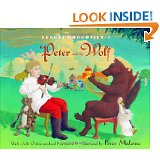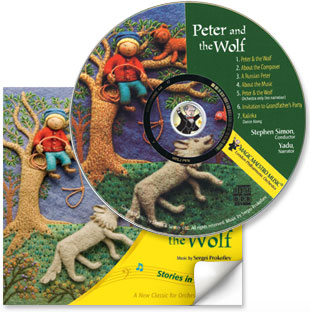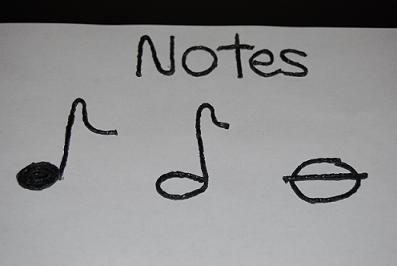
Sergei Prokofiev’s Peter and the Wolf is a composition written for chamber orchestra and narrator. It is one of Prokofiev’s cherished works and will delight children while offering an opportunity to learn important skills through classical music.
Sergei Prokofiev (1891-1953) was born in Russia (show the children on a world map where Russia is located in relationship to where they live). Sergei began learning piano from his mother, an accomplished pianist, at age 3. By the time Sergei was 5 years old, he had written compositions for the piano; at 9 years of age, Sergei had written opera.
Prokofiev spent time in the United States, but moved to Paris and London. In 1936, he returned to Russia. When in his homeland, Prokofiev wrote Peter and the Wolf for a children’s theater in Moscow. It was a huge success and has become a beloved classic among both children and adults.
Learning Objectives:
1) to use aural and visual skills to identify a variety of instruments/instrument families/instrumental themes;
2) to explore how music can convey different emotions; and
3) to extend the story through: movement, story sequencing and retelling, and musical art.

Maestro Classics is a great educational resource for all of the classics. The Peter and the Wolf book and CD collection will have value for years to come!
Musical Themes
Prokofiev introduces a variety of instrument families and characters through instrumental themes in Peter and the Wolf. Peter is played by the violin (string instrument family); the bird is played by the flute (woodwind family); the duck is played by the oboe (woodwind family); the cat is played by the clarinet (woodwind family), the Grandfather is played by the bassoon (woodwind family); the Wolf is played by the french horn (brass family); and the Hunters are played by the timpani (percussion family).
Print and download the Instrument Cards – Peter and the Wolf. Play a recording of Peter and the Wolf for the children. As each instrument (character) is introduced, stop the recording and show the children the picture card of the corresponding instrument. Discuss the instrument family each instrument belongs to as the cards are explored (Prokofiev introduces the string, woodwind, brass, and percussion instrument families in Peter and the Wolf).
Our kids love the animated Disney version (links below) because the animals are given names: the cat (Sonia), the bird (Sasha), and the duck (Ivan). As the children begin to recognize each of the instruments, they will quickly associate each animal’s name with the corresponding instrument. They will delight in saying, “That’s SASHA, played by the FLUTE!” As the children become more familiar with the instruments, print a copy of the cards for each child. When the recording is played, ask the children to hold up the corresponding instrument cards. The instrument card file can also be printed and used as a matching activity, if desired.
Music. Feelings, and Emotions – a listening map
Music embodies powerful emotions for adults and for children. It can soothe, excite, express sadness, uplift, be humorous, and create joy among many other feelings. When listening to Peter and the Wolf, ask the children how each of the instrumental themes make them feel. Help the children use descriptive words as they listen to each of the characters and their corresponding instruments. Does the instrument sound happy, sad, heavy, loud, light, soft, strict, harsh, smooth, sneaky, slow, strong, determined, fast, or relaxed? Help the children form a listening map for Peter and the Wolf.
Example of a Listening Map:
1) Peter enters the meadow – how does the music sound – does the music sound light or scary?
2) We meet the Bird – is the music fast or slow?
3) We meet the Duck – do the children LIKE the unique sound of the oboe? Can they almost FEEL the duck waddling?
4) We meet the Cat – does the clarinet sound relaxing and smooth or heavy and harsh?
5) Grandpa arrives – does the bassoon sound happy or angry?
6) We meet the Hunters – is the sound of the french horn light/happy or strong/determined?
7) Peter ropes the Wolf – does the music get faster or slower to help us FEEL specific ACTIONS?
Extension Activity: Play the recording and ask the children to freely move to the music (let the children use scarves or streamers, if desired). It is an amazing sight to watch children moving to Peter and the Wolf. It is an expressive activity that will allow the children time to feel and incorporate the music in their own way. After the movement activity, ask the children how they felt as the music played. Help the children to find words for their movements (skipping, fluttering, prowling, waddling, floating, flying, stomping, crawling, marching, twirling, etc.)
Story Sequencing and Retelling – Peter and the Wolf Sequencing Strips
Print the Sequencing Strips (linked above) for the children. Read each of the strips to the children (the strips contain the corresponding instrument as a visual aid). Have the children try to retell the story by placing the sequencing strips in the appropriate order. The children could also retell the story in their own words. We digitally record the children as they retell the story to play it back for our group as we continue learning.
Musical Creations and Rhythms
Ask the children to free draw or paint while listening to Peter and the Wolf. It is fun to watch the children draw as the different themes are introduced. Some children will choose black for the wolf and lighter colors for the bird. Painting and drawing can help the children express the emotions felt by listening that they do not have the vocabulary for quite yet.

Introducing children to basic music notes will invite the children to practice important rhythms.
Quarter note: a quarter note gets ONE whole beat. Have the children use Wikki Stix to make a quarter note. Ask the children to clap and say, “quarter” with each rhythmic clap they make. We use the metronome app by Frozen Ape Pte. Ltd. in our classroom which helps the children establish rhythms as they clap ($1.99 on iTunes). Teaching children to “keep a beat” will help their bodies incorporate the rhythms that will enhance future reading skills.
Half note: a half note gets TWO counts. Have the children use Wikki Stix to create a half note. Ask the children to clap and hold the clap for two counts. We clap and say, “Half note/ HOLD IT” before we clap again.
Whole note: a whole note gets FOUR beats. Have the children use Wikki Stix to create a whole note. Ask the children to clap and hold the clap for four counts. We clap and say, “Whole/ note/ four/ beats/” before we clap again.
Extension: Ask the children to do different movements while learning music note values: jumping, hopping, bending, reaching, etc.
Resource links:
Free Printable/Ideas for a Peter and the Wolf Puppet Theater
Peter and the Wolf CD and Book – Maestro Classics
Prokofiev and Walt Disney You Tube
Musical Instruments Coloring Pages
Learning about Instrument Families
Interactive World Map